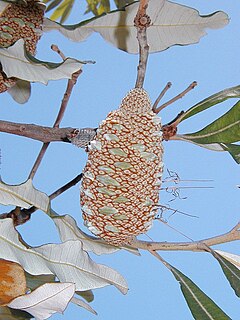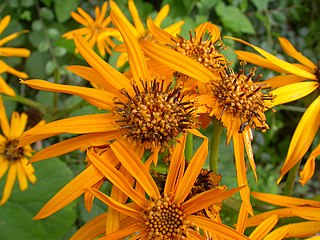Related Research Articles

Lavandula is a genus of 47 known species of flowering plants in the mint family, Lamiaceae. It is native to the Old World and is found in Cape Verde and the Canary Islands, and from Europe across to northern and eastern Africa, the Mediterranean, southwest Asia to southeast India.

The Pyraloidea are a moth superfamily containing about 16,000 described species worldwide, and probably at least as many more remain to be described. They are generally fairly small moths, and as such, they have been traditionally associated with the paraphyletic Microlepidoptera.

Rhus dentata, the nana-berry (English), or nanabessie (Afrikaans), is a medium sized, deciduous tree, reaching a height of about 5 metres and a spread of 4 metres, and with a tendency to scramble through and over neighbouring trees. It occurs naturally in almost the whole of South Africa except the Western and Northern Cape Provinces. Its habitat varies from sea level to the highlands of the Drakensberg. It is frost-hardy and should be planted in full sun. The strongly aromatic leaves are usually conspicuously toothed, though sometimes they may be only slightly toothed. The tree produces small, creamy-white flowers in masses, developing into small, flattened drupes (5-6mm) which turn red or orange when ripe and brown when dry. The ripe fruits are eaten by birds, while the foliage is food for the larvae of the pepper tree moth Bombycomorpha bifascia.

Quercus dentata, also called Japanese emperor oak or daimyo oak is a species of oak native to East Asia. The name of the tree is often translated as "sweet oak" in English to distinguish it from Western varieties.

Banksia dentata, commonly known as the tropical banksia, is a species of tree in the genus Banksia. It occurs across northern Australia, southern New Guinea and the Aru Islands. Growing as a gnarled tree to 7 m (23 ft) high, it has large green leaves up to 22 cm (8.7 in) long with dentate (toothed) margins. The cylindrical yellow inflorescences, up to 13 cm (5.1 in) high, appear over the cooler months, attracting various species of honeyeaters, sunbirds, the sugar glider and a variety of insects. Flowers fall off the ageing spikes, which swell and develop follicles containing up to two viable seeds each.
The Field Elm cultivar Ulmus minor 'Albo-Dentata' first featured in the Baudriller nursery catalogue of 1880 as U. microphylla foliis albo-dentata. It was distributed by the Späth nursery of Berlin in the late 19th and early 20th century, as U. campestris microphylla fol. albo-dentatis.

Ligularia dentata is a species of flowering plant in the genus Ligularia and the family Asteraceae, native to China and Japan.

Cyclemys is a genus of freshwater turtles, commonly referred to as Asian leaf turtles, from the family Geoemydidae. The genus occurs throughout Southeast and South Asia, and currently contains seven species.

Vagina dentata describes a folk tale in which a woman's vagina is said to contain teeth, with the associated implication that sexual intercourse might result in injury, emasculation, or castration for the man involved. The topic of "vagina dentata" may also cover a rare medical condition affecting the vagina, in which case it is more accurately termed a vaginal dermoid cyst.

Agrotera is a genus of snout moths in the subfamily Spilomelinae of the family Crambidae. It is the type genus of the tribe Agroterini and currently comprises 28 species distributed in the Afrotropical, Palearctic, Indomalayan and Australasian realm.
Hydropionea is a genus of moths of the family Crambidae. The 13 described species are distributed in Central and South America.
Coenochroa is a genus of snout moths. It was described by Ragonot, in 1887.

Zophodia is a genus of snout moths in the subfamily Phycitinae. It was erected by Jacob Hübner in 1825.

Melitara is a genus of snout moths in the subfamily Phycitinae. It was described by Francis Walker in 1863. Some sources list it as a synonym of Zophodia, while others retain it as a valid genus.

Guinotia dentata, commonly known as cyrique, is a West Indian species of freshwater crab in the family Pseudothelphusidae. They have few predators. They are easily caught and thus are used locally as a food source.
Nefundella is a genus of snout moths. It was described by Herbert H. Neunzig in 1986.
Nefundella distractor is a species of snout moth in the genus Nefundella. It is found in Puerto Rico.
Nefundella xalapensis is a species of snout moth in the genus Nefundella. It is found in Mexico.
Hydropionea dentata is a moth in the family Crambidae. It was described by Herbert Druce in 1895. It is found in Guatemala.

Lomatia dentata, commonly known as piñol or avellanillo, is a species of tree in the family Proteaceae.
References
- ↑ "World Pyraloidea Database". Globiz.pyraloidea.org. Retrieved 2011-09-29.
- ↑ Beccaloni, G.; Scoble, M.; Kitching, I.; Simonsen, T.; Robinson, G.; Pitkin, B.; Hine, A.; Lyal, C., eds. (2003). "Nefundella dentata". The Global Lepidoptera Names Index . Natural History Museum . Retrieved May 11, 2018.
| This Phycitini-related article is a stub. You can help Wikipedia by expanding it. |